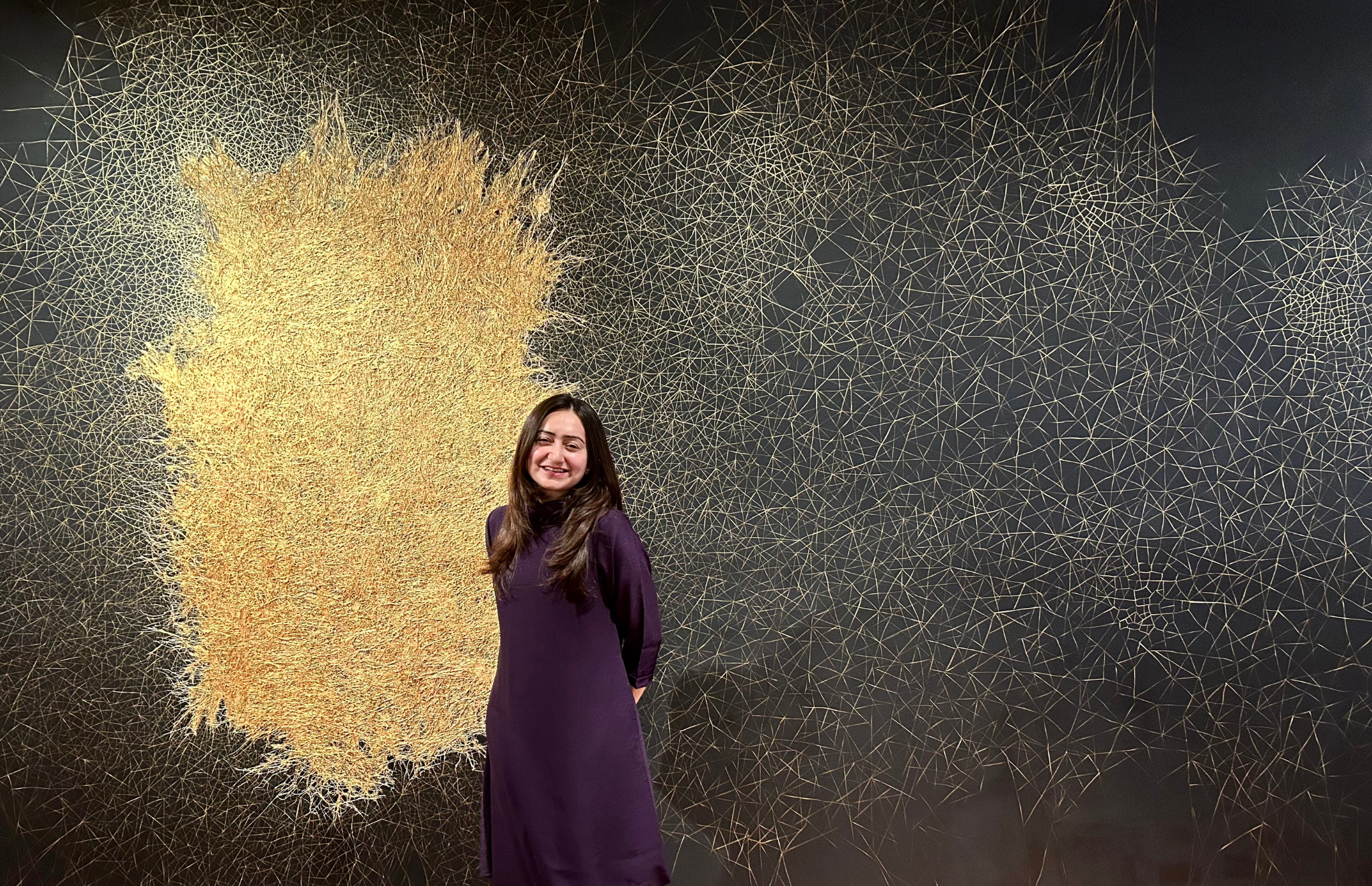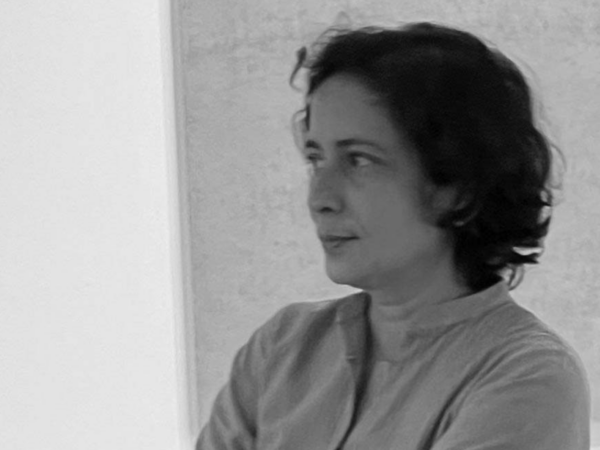Penny Slinger, born in London in 1947 and now based in LA, is a surrealist, feminist, and tantric collage artist. Her work merges these influences, exploring the feminine by often using herself as a muse, reflecting both how a woman is seen and how she sees herself. After attending Farnham Girls’ Grammar School, she studied at Farnham School of Art from 1964 to 1966, followed by a Diploma at Chelsea College of Art, where she graduated with First-Class Honors in 1969. Though accepted into the Royal College of Art’s postgraduate Film course, she chose to collaborate with filmmaker Peter Whitehead instead.

Photo courtesy: Nick Berardi
SP: Regarding the evolution of women’s role in the contemporary arts, what challenges do you still face while defining the genre your art talks of?
PS: Fads and fashions come and go. Recognition of the significance of women in the history of art has been on the rise but has still reached nothing like a place of parity. At this point, it appears that ethnicity and gender fluidity is receiving attention. Currently, painting is more in vogue than the photographic collage approach that I employ. I feel this genre will rise again and be recognised as one of the most important modes of artistic expression of our times. My genre is also defined by radical self-examination and self-expression. This may be still a wave of the future, though I see many emerging women artists gravitate towards it. We seek to know ourselves and to express ourselves. This may still be seen as challenging to the status quo, both for society and the art world. It is perhaps too honest, too real, for many to handle. For me, it is the heroine’s path, and I will continue to pursue it with passion and intensity. We cannot be content with surfaces any longer, we need to dig deep to excavate the long-hidden truths of who we are in order to have a positive and transformative effect on social convention. That is the real job of the artist I believe, and it is crucial that this liberated feminine spirit be allowed full reign of self-expression in order to bring about the kind of social change that is the path of evolution for humanity now.

Photo courtesy: Penny Slinger
SP: Your practice spans various mediums including photography, collage, film, and sculpture — do you find one medium particularly powerful for expressing certain themes?
PS: I have always enjoyed mixing different media. I started employing photography when I was a student. I did not see it really as a medium in itself, but as part of my toolkit, I could use it to realise my visions and to mix it with other means of expression in a broader palette.
While at art school, I used photography in my work in various ways. I was inspired by Marcel Duchamp’s Nude Descending a Staircase as I liked the idea of expressing time and motion in a work. I liked the way photography could capture a fleeting moment that would be hard to record in a study rendered in other media, so I used photography as both an end result and as a way of recording something that I could then translate into other media — a drawing, a painting, a print.
From a very early age, I enjoyed cutting up magazines and pasting images and parts of them together in different ways, but it was not until I discovered the collage books of Max Ernst — which utilised old engravings as source material — that I really got to understood that collage could be used to portray immersive dreamscapes and embody subconscious mythology. I had assumed that in collage, one would always see where the pieces were stuck together, but Max Ernst’s Une Semaine de Bonte and La Femme 100 Tetes created seamless visions with collage that opened my mind to the possibilities it presented. I wrote my thesis on his books, made an animated film on the works, and created my first book of collages and poems called 50% The Visible Woman (1969), with the intention of depicting the lesser-mined feminine psyche, from the inside out.
So, to sum up, I would say the collage approach is one that I have employed over a cross platform of media — always seeking to disrupt and disturb the ‘seen’ and reveal the unseen.

Photo courtesy: Penny Slinger
SP: Your work has been part of numerous exhibitions, for instance, ‘Feminist Avant-Garde of the 1970s’ and ‘Angels of Anarchy’. How do you perceive your role and impact within the broader feminist art movement?
PS: I never labelled my work as ‘feminist’ as such, though I feel it is primarily engaged in the liberation of the feminine. I have taken a specific approach, distinct from much feminist initiative, in that I have sought to reclaim the female body and its right to pleasure as part of our empowerment. Understanding that we are all, male and female alike, composed of male and female elements, nevertheless I felt it was time for us to be recognised and respected for all we are, which includes, not excludes, our sexuality, our fantasies, our intuition, and our dreams. I did not want us to become more like men, in order to have their power in society — I wanted us to become more ourselves, more able to own our right to own our psychosexual beings, and that liberating those energies would be the key to healing our wounded selves. The degradation of the feminine in favour of the masculine has plagued our culture for a long time. It is time for her pride of place to be claimed, not only by the female of the species, but in the hearts and souls of men as well.

Photo courtesy: Penny Slinger
SP: What drew you to explore themes of sexuality, mysticism, and femininity through self-portraiture and body imagery?
PS: My body is my temple. I wanted to find ways to communicate that truth, so lost to many in a secular society and where religious beliefs have shrouded the body in guilt and shame. I wanted to lift that veil and reveal a reborn sense of self which could mirror our inner potential once we remove these limiting and limited concepts. Sex can be sacred, not sinful. That is the freedom offered by the path of tantra, which I willingly embraced once I discovered this mystical tradition. It is the path of the Goddess, for it includes all and everything, spirit and matter, in its all-encompassing liberation.
So, all this I wished to inscribe on the canvas of my own being, and hold it up, like a mirror, for others to behold and see their own reflection looking back. I am the person I know best. I am the one with whose self-image I could be most ruthless, most candid. I am a woman, so that is the lens I view all through, that is the ground of my being, and I wanted to explore all its facets — both how I am seen and how I see myself. I am a multi-faceted jewel, a diamond squeezed from the raw coal of my earthly substance. I wanted to examine every facet, and that meant bringing forth the sexual/sensual and the mystical in trying to reach the essence of this feminine being and lay it bare.

Photo courtesy: Penny Slinger
SP: What are arts to you, and who do you have looked up to mostly throughout the rollercoaster journey since the beginning to this day, and what’s your plans for future projects?
PS: The arts represent to me a way to crystallise the experience of life and leave a record — a blueprint, of what my life has meant, what insights I have gleaned, what alchemy I have performed on the raw material of my incarnate self.
While a student at Farnham School of Art (now Surrey Institute of Art and Design), I was especially inspired by the work of Giacometti and Egon Schiele. I found them both to have such intensity expressed in their renditions, achieved in very different ways. Schiele had a facility and fluidity of line that could achieve an emotional impact with a sparsity that was stunning. On the other hand, the work of Giacometti was built and built with a network of lines that reflected his single pointed immersion in his subject with great depth and feeling, seeming to build the form of the being from the inside out.

Photo courtesy: Penny Slinger

Photo courtesy: Penny Slinger
I went to Chelsea College of Art after that, where my sketch book showed references to the plastic arts, film and poetry. These include the art and poetry of William Blake, T. S. Eliot’s Four Quartets, the photography of Muybridge, Bill Brandt and Lucien Clergue, paintings by Francis Bacon and Ashile Gorky, Picasso’s Guernica and boxes by Joseph Cornell. Allen Jones taught part time at Chelsea, and he was my favourite artist and teacher. I loved Cocteau’s films and films like L’Age D’Or by Dali and Bunuel. Although I did not discover her work until later in life, I had a reference image from Frida Kahlo. She is the woman artist with whom I feel most kinship. As I mentioned earlier, the collage work of Max Ernst became a seminal inspiration.
Currently, I have an immersive exhibition I designed at Richard Saltoun Gallery, London, featuring the collages from the Exorcism series, to accompany the publication of An Exorcism: A Photo Romance. This was inspired by the project I worked on in 2019, where I was invited by Maria Grazia Chiuri, Head designer at Dior, to create an immersive environment at their historic building in Paris for the last haute couture fashion show they were to have there. I conceived an alchemical formula for this project and, with the help of my creative partner, Dhiren Dasu, and the production company that works with Dior, we covered all the walls, floors, and ceiling of the salons, entryway and stairwell with images of the elements. I hope to do more projects along these immersive lines.

Photo courtesy: Penny Slinger
I am working on an ongoing series entitled My Body, which, in the form of photographic collage, features my, often naked, body at this age as the canvas on which to display my body of experience. I am using myself as my own muse, regardless of my advanced years, as I wish to exhibit my continuing relevance and burst through the glass ceiling of ageism — which I see as a scourge to society, as it limits the wisdom of our ‘wise women’ from being able to percolate back into society and culture. In this way, we remain collectively immature and make choices based on a lack of the wisdom of experience. I want to try and do something about this, and, as is typical of my practice, I am employing my own being as the vehicle.
Lastly, I am working on my archives. The experience of my life as art is broad and expansive. It is well documented and, as such, I believe, supplies an invaluable template that reflects human potential and the ability of a woman to self-actualise across a variety of media and life situations. I see it as a roadmap to self-realisation and I wish to leave the signposts in the sand as grains in my hourglass, responding to the force of gravity.
SP: Merging your writings and collages in “An Exorcism’’, how has this writing duration helped you grow as an author?
PS: From the start I have always tended to express myself in words as well as images. This came naturally to me and words fall into my head, as poetry, like music and song, and I just need to inscribe them. These come from a plane of consciousness available to us all, and we just need to find ways to tap in. I feel these are gifts, and I just want to pass these gifts on.
The writing for An Exorcism: A Photo Romance was done back in the 1970s. It is only being published now, but it was completed as a work at that time. So, my ‘authoring’ has been established for a long time. My book 50% The Visible Woman, first published in 1971, combined collages with poetry on transparent overlaid sheets, placing the words deliberately in relationship to the collages underneath. In this way I wanted to cement the undeniable connection I felt between the words and the images. I enjoy writing in poetic form as it feels like the perfect compliment to visual collage, not being driven by narrative and linear concepts.

Photo Courtesy: Penny Slinger
One of the things that I feel has helped me most in being able to speak in public in an un-self-conscious way is the work I did in the early 2000s. At that time, I had a musical entity entitled the Goddess Frequency Band. Our practice involved making music without preconception. We would just say, “One, two, three go!” and see what spontaneously manifested. My role was to deliver spoken word. This involved relinquishing the censorship of my conscious mind and any controlling factors my individual self may exert and allowing whatever words that dropped into this open mind space to be spoken aloud by me. There was no safety net, just faith in the process.
I found that after working with this template over the years that I co-created with the band, it had the effect of freeing me to allow thoughts to be articulated without self-consciousness when involved in public speaking.

Photo courtesy: Penny Slinger
SP: What advice would you like to share with the young and emerging artists who are navigating the art world and finding their artistic voices?
PS: To your own self be true. This is the main dictum. All else is secondary. Seek your inner voice and find ways to bring it forth. Hone your skills so that you may support your means of expression in the very best way you can. Know that all techniques are but in service to a higher truth and let that truth shine through all you do, despite what feedback you may get and whether you are seen and understood. The art world is just another expression of maya (illusion) and it will beat you up as much as it lauds you. Seek neither to be puffed up by its flattery nor defeated by its rebuttals. That is the way of the world, and it flourishes in the world of art as much as in other domains.

Photo courtesy: Penny Slinger
Look at the history of art and find what lineage inspires you most, where you feel most resonance, then find your place within it, singular and unique.
Understand that taking the path of the artist means forsaking the path of ‘security’. There is no security to be found here, only the refuge of your own inner passion and drive. You must learn not to be dismayed and disappointed by your perceived failures, for they will be many. But only choose to walk this path if you are called so strongly that there is no other way. Only then will you have the inner strength to endure the hardships that will surely come. Only then will you be able to keep the faith, no matter what the circumstances. Your belief in yourself must be adamantine, for this is all you truly have to fall back on.
Image Courtesy: Nick Berardi and Penny Slinger
Find out more about the artist and her artworks:





